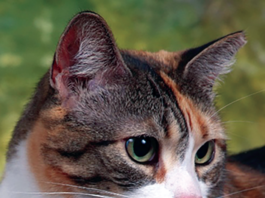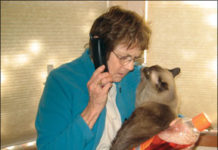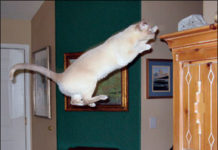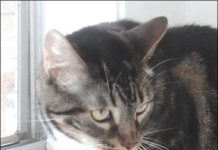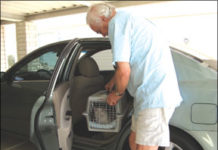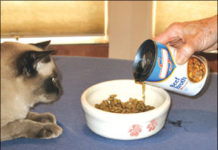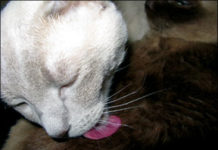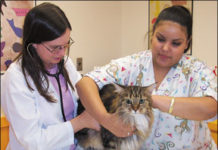And It’s … Show Time!
According to Caroline Fralia of Ft. Worth, TX, "Fenix" is "just a brown, mackerel tabby cat" that she rescued as a kitten. Fenix may have come from humble beginnings; however, the tabby cat is quite famous in the show ring: "Fenix of Strayinc" attained the title of Supreme Grand Master (SGM) in 2002, as well as the ranking of 20th in the world in The International Cat Association (TICA) Household Pet (HHP) division. Who would have thought that a rescued cat could become a noted show kitty? "The majority of people showing either grew up with an HHP or started showing with an HHP," says Fralia, who started showing in 1992 with a pet cat. "It was interesting," she laughs. One of her cats let her know immediately that showing wasnt for him, but another one gave her more hope - and thats all it took. The excitement of showing her own pets drew Fralia to cat showing; however, it was the people who made her want to stay. Fralia notes that everyone - from fellow competitors to judges - was extremely supportive. "Theres a sense of camaraderie among [HHP] exhibitors," she explains.
Finding Emergency Care
Perhaps the most important characteristic of a responsible cat owner is the ability to distinguish the signs of minor feline illnesses from those calling for an immediate trip to the nearest animal emergency care facility. Cat owners should be equipped ahead of time to deal promptly with such a crisis. They should know precisely where the clinic is located, the speediest route to get there, how to transport the afflicted animal, what documents they should take to the facility - and what to expect to happen upon arrival. Feline emergency cases are by no means rare, says Gretchen Schoeffler, DVM, chief of emergency and critical care services at the Cornell University Hospital for Animals (CUHA). She and her colleagues typically treat as many as 10 or 15 severely ill cats each week in the hospitals emergency unit, which, like most such facilities in the U.S., is open 24 hours a day, seven days a week.
Your Cat’s Amazing Grace
If you asked Mother Nature, "What is the most athletic animal in the world?" She would most likely answer "the cat." If in doubt, watch your feline in perfect, graceful flight up the kitchen table to the inside of a cupboard - without touching a thing. Your cats agility and sense of balance is one of her most outstanding features. Heres how it works - and how it can go awry. Biologists say that cats havent changed for the past ten million years. "The big cats, such as lions, tigers and jaguars, and the small cats are almost identical in their agility and flexibility," explains Mark Lotz, panther biologist with the Florida Fish & Wildlife Conservation Commission. "If you watch cats hunt - large or small - they all possess the same skills of pouncing, stalking low to the ground and launching off at top speed to chase their prey."
The Beautiful Tabby
Without even seeing your cat, Joan Miller, vice-president of the Cat Fanciers Association, knows your cat is a tabby. Impossible, you say. My cat is a Persian. Or my cat is a plain black alley cat. How does Miller decide that your cat is a tabby? "Because all cats are tabbies, genetically speaking," explains Miller. "All cats have a pattern of stripes, blotches, spots or whorls. If they have the dominant gene, theyre called Agouti - and they show the tabby pattern. If they receive the recessive gene, theyre known as non-Agouti, and they will be a solid color with no pattern." However, you can often still see the tabby markings underneath as a ghost pattern. The next time you get the chance, look at a black cat in the sun. You should be able to see the hint of a tabby pattern. "This is a lot easier to see in kittens," says Miller.
Taking Felix on Vacation?
Thinking about going on a leisurely week-long auto trip? Good for you! Thinking about taking your cat along for the ride? Youd better think twice about that, advises Julia Albright, MA, DVM, a resident of animal behavior at Cornell Universitys College of Veterinary Medicine. Theres a good chance, she maintains, that your pet would just as soon stay at home while you and the rest of your family pull out of the driveway. "You might really want to take your cat along," says Dr. Albright, "and thats totally understandable. But I would recommend that you leave the animal at home unless it has already shown that it likes to travel and wont get stressed out by the experience -and I havent met very many of those cats. In general, cats dont do very well with change, and traveling for hours on end in the back seat of a car would certainly come under the heading of change." For owners who cant bear the idea of putting their cats in a kennel for a week or so or leaving them at home in the care of a neighbor or professional pet sitter, Dr. Albright has some words of advice.
Two’s Company Sometimes
Cats are naturally solitary creatures; in addition, they are also naturally independent and self-sufficient traits that we alter and/or suppress when we domesticate them. The idea of a second cat can be very alluring: "One cat is so entertaining and such a wonderful companion
two would be twice the fun!" Or, "I want to do my part to ease the burden on my local shelter and give one more cat a good home." These are common thoughts for cat owners and may, in fact, be true; however, the decision to add a second feline family member should not be taken lightly. A second cat can either add joy and companionship, or it can add strife and mayhem. Dr. Julia Albright, resident of animal behavior at Cornell Universitys College of Veterinary Medicine, states, "Cats may tolerate, but rarely enjoy the company of another cat. I see so many problems from people having too many cats, but shelters are so overcrowded with cats that I hate to deter people from providing good homes."
Two’s Company -Sometimes
Cats are naturally solitary creatures; in addition, they are also naturally independent and self-sufficient - traits that we alter and/or suppress when we domesticate them. The idea of a second cat can be very alluring: "One cat is so entertaining and such a wonderful companion … two would be twice the fun!" Or, "I want to do my part to ease the burden on my local shelter and give one more cat a good home." These are common thoughts for cat owners and may, in fact, be true; however, the decision to add a second feline family member should not be taken lightly. A second cat can either add joy and companionship, or it can add strife and mayhem. Dr. Julia Albright, resident of animal behavior at Cornell Universitys College of Veterinary Medicine, states, "Cats may tolerate, but rarely enjoy the company of another cat. I see so many problems from people having too many cats, but shelters are so overcrowded with cats that I hate to deter people from providing good homes."
Feeding the Stressed Cat
Fires in California last fall caused more than 300,000 residents and their pets to flee their homes. This spring, an estimated 1,000 dogs and cats in Iowa, Indiana and Missouri were temporarily relocated or found stranded as a result of recent flooding in these areas. And dont forget Hurricane Katrina, which displaced an estimated 50,000 animals in 2005. A house pet that suddenly finds itself in a noisy, unfamiliar shelter, or worse yet, barely clinging to life from the peak of a rooftop, suffers from a high level of stress. Though your feline hopefully will never experience this level of stress, the physical responses to stress - whatever the cause - are similar. So, whether the cause of a cats stress is a catastrophic disaster or the addition of a new kitten into the home, much can be learned from those who routinely work with stressed felines and applied to our house cats - particularly when it comes to feeding and nutrition.
The Reasons for Grooming
When you have the time, sit down and watch your cat go through her grooming ritual. First the paws, then the sides of the face, behind the ears, the chest. Its a fascinating process because almost all cats do it the same way. By the time you cat reaches adulthood, she will spend about 30 to 50 percent of her waking time grooming herself, explains Cynthia L. McManis, DVM, board-certified by the American Board of Veterinary Practitioners. Time will vary among species and individual cats. Longhaired cats will or should spend more time. Overweight cats may spend less time grooming themselves because its too difficult to reach some places. If your mischievous male gets himself into something messy, he will devote a significant amount of time to cleaning off a particular area.
Keeping Elderly and Their Cats Together
Mary Jones has been living in New York City with her housemate Alice for the past ten years. Mary and Alice are actually about the same age. Both want to stay together for as long as they can take care of each other. But Mary is an 80-year-old widow and Alice is an 11-year-old domestic shorthair. Marys eyes arent as good as they used to be, and her arthritis bothers her when she bends over. So she worries how she will keep on cleaning Alices litter box and carrying the heavy bag of cat food up the stairs. And she wonders what will happen to Alice if her beloved companion outlives her. Weve heard a lot over the past several years about how older people benefit both emotionally and physically from living with pets. The problem is this: As people get older, they often experience disabilities which may prevent them for fully caring for the pets they love. What can older people do?
Understand Skin Disorders
The function of your cats skin extends well beyond its role as the matrix for the animals lustrous haircoat. In a healthy feline, the skin also works, for example, as a barrier against invasion by harmful microorganisms. It serves as a watertight seal, retaining an animals body fluids and preventing dehydration. And it insulates an animals internal organs against the outside worlds extremes of heat and cold. Despite its normally durable structure, however, every cats skin is subject to a wide array of disorders, most of which are minor and readily treatable. But some untreated skin conditions can rapidly progress to a serious, even lethal, stage, with systemic implications. Considering the dangerous potential of virtually any untreated skin condition, William H. Miller Jr., VMD, a professor of dermatology at Cornell Universitys College of Veterinary Medicine, strongly urges cat owners to practice what he terms "preventive maintenance." Keep an eye out, he advises, for any suspicious scratching or hair loss that might suggest the presence of a parasitic, bacterial or fungal infection. Take note of any skin wounds, growths or swollen areas on the skin, no matter how inconsequential they may seem. And seek the counsel of a veterinary dermatologist if any such suspicious signs appear.
Helping a Child Cope With Pet Loss
Kids and pets are like peanut butter and jelly - its hard to imagine one without the other. They can quickly become the best of friends, playing for hours on end. A childs best animal friends seem to know to be extra gentle with him, and they are often endlessly patient - calmly swallowing their pride and allowing themselves to be dressed in dolls clothes, take a bubble bath or just be hauled around on the childs whim. Regardless, the attachments between children and their pets can be very real and very strong, making it especially difficult when the pet dies. And, while we dont usually like to think about death, it is a part of life. Fortunately, there are several simple ways a parent can help a child understand and work through the grieving process.



